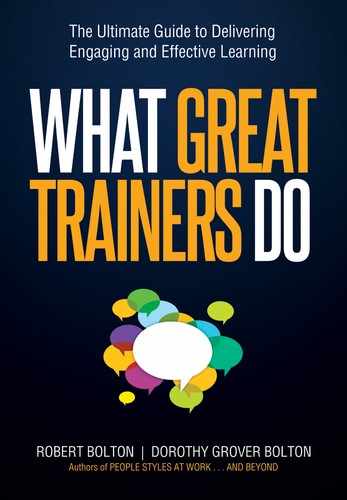Preface
A teacher affects eternity; he can never tell where his influence stops.
——Henry Adams1
The fundamentals of any discipline are skills that have been learned from exemplars, honed by mindful practice, and improved by disciplined innovation. In a master trainer, these skills are so deeply ingrained in the trainer’s behavior that they seem to be innate—yet they can be analyzed and learned by anyone committed to mastering the craft of training.
This book is based on the Craft of Training workshops that we and our colleagues delivered primarily at Fortune 500 corporations but also in smaller companies and numerous not-for-profit organizations. Over the last three decades, the workshop has undergone numerous revisions and endless tweaking.
In these pages you’ll learn how to lead dynamic workshops. In music, the term dynamics refers to the degrees of loudness that give expression and meaning to the notes that otherwise might sound mechanical. Dynamics provide the variety that helps the music live and breathe. So, too, the term dynamic in the field of training refers to an instructional method that energizes participants through a varied approach that invites lively participation and enhances the learning and retention of the workshop content.
Dynamic training is invigorated by group interaction. In contrast to one-to-one instruction, however, teaching groups of people creates a much more complex set of challenges. Within a group, each person’s learning is affected—for better or worse— not only by his or her own thought processes and emotions but also by the complex set of group interactions that influence the learning experience. Dynamic trainers not only master their subject matter but also understand and work effectively with the most important elements of group process.
This leads to the question of what is the best way to grapple with this training material. It cannot be read as one would read either fiction or other nonfiction. The content of the chapters is to be read, studied, tried out, and read again to gain a deeper understanding, and then practiced again and again. This is the way we trained more than sixty men and women over the years who were selected to become trainers in our organization.
The following anecdote will give you an idea of how effective these methods are. A client was seriously considering purchasing one of our courses for a large training group. Wisely, the client decided to send one of his course developers to participate in a workshop and evaluate the quality and appropriateness of the course for the company’s needs. The report on the workshop came back to the company as positive on all counts, with one exception: “The course is too complex for any but the most experienced and skilled trainer to lead. This trainer’s superb training skills are essential to the effectiveness of the course. Since the rollout is to be large and extend over a year’s period and would require more than eight trainers to handle the project, I can’t recommend it.”
In response, we suggested that the course be given again and led by a younger, much less experienced trainer, and that the same evaluator attend again. That was agreed upon. The second evaluation came back, “I was wrong. These folks have figured out how to train trainers so that the quality of the training remains exceptionally high even in the hands of fairly new and unseasoned trainers.”
This book provides how-to descriptions of the training methods those trainers used.
Turn the page and let’s begin.
